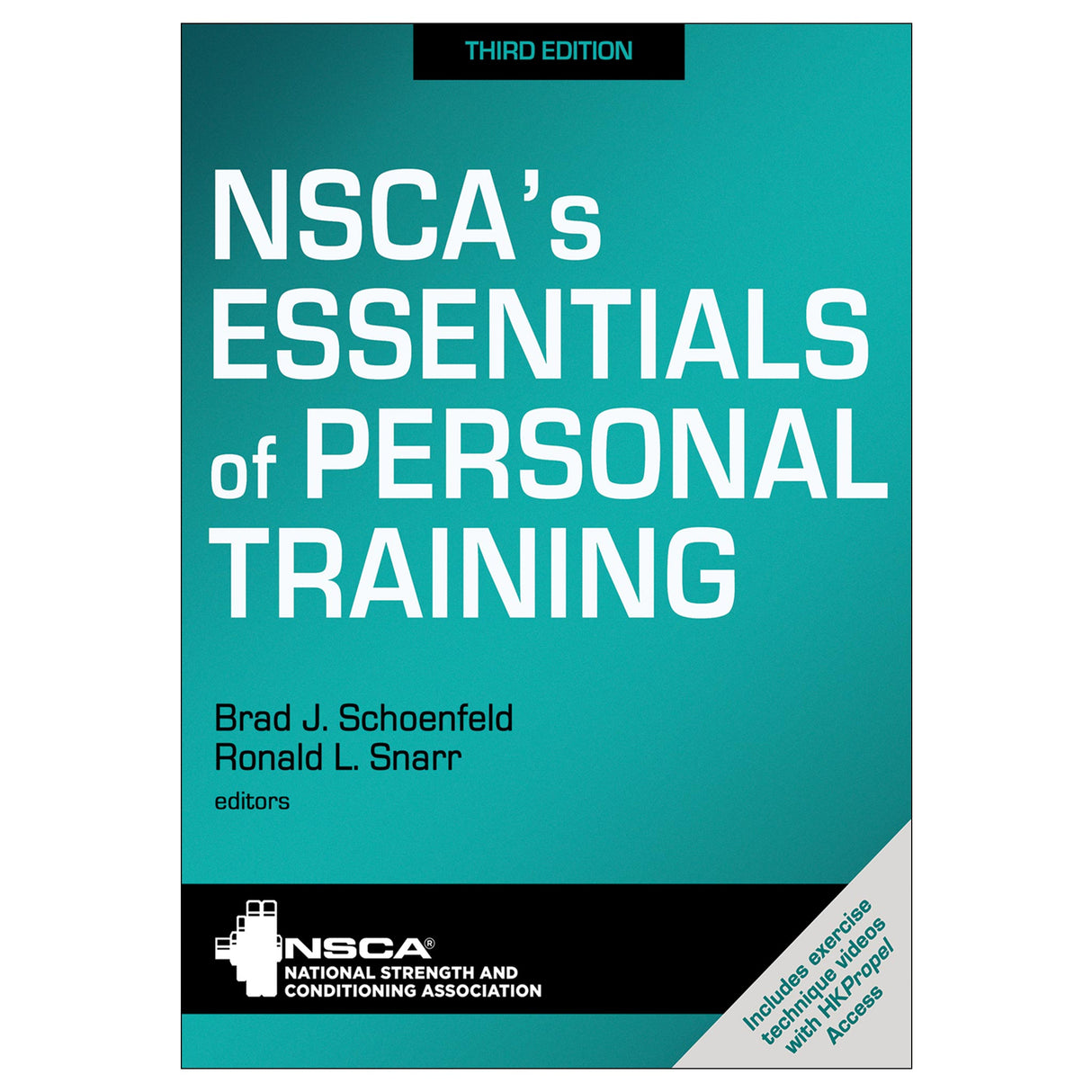NSCA's Essentials of Personal Training 3rd Edition Ebook With HKPropel Access
$89.00 USD

Updated to reflect the latest research, with clear explanations of supporting scientific evidence, this edition will give readers the knowledge, skills, and abilities (KSAs) needed by modern personal training professionals. New content addresses the latest objectives found on the National Strength and Conditioning Association’s Certified Personal Trainer (NSCA-CPT) exam, maintaining this text’s position as the single best resource for those preparing for the NSCA-CPT exam.
NSCA’s Essentials of Personal Training, Third Edition, provides guidelines for the complex process of designing safe, effective, and goal-specific resistance, aerobic, plyometric, and speed training programs for clients of all ages and fitness levels. With comprehensive coverage of various categories of unique client needs, readers will learn how to make specific modifications and adjust exercise programs for each individual client. Multiple fitness testing protocols and norms for each component of fitness—including 10 new tests—are all presented, along with instructions that are detailed yet easy to follow.
Over 200 full-color photos and accompanying instructions clearly describe and visually show proper technique for exercises and drills, including stretching, plyometrics, and stability ball exercises. There are new sections on suspension training, manual resistance training, and common types of resistance training equipment. Plus, 27 online videos, delivered through HKPropel, demonstrate exercise technique in action, preparing readers to instruct clients through safe exercise performance. Students will also be able to complete chapter quizzes assigned by instructors through HKPropel.
Study questions at the end of each chapter, written in the same style and format as those found on the NSCA-CPT exam, facilitate learning of chapter content and fully prepare candidates for exam day. Practicing professionals and aspiring professionals alike will benefit from a new appendix of advice on building a successful career as a personal trainer.
NSCA’s Essentials of Personal Training, Third Edition, remains the most comprehensive resource available for personal training preparation and professional development. Unmatched in scope, this essential text continues to be a definitive reference for current and future personal trainers, exercise instructors, fitness facility and wellness center managers, and other fitness professionals.
Note: A code for accessing HKPropel is included with this ebook.
Audience
Resource for personal trainers, exercise instructors, fitness facility and wellness center managers, and other fitness professionals. Also the primary preparation source for the NSCA-Certified Personal Trainer examination.Jared W. Coburn, PhD, and Moh H. Malek, PhD
Chapter 2. Structure and Function of the Cardiorespiratory System
Michael R. Esco, PhD, and Moh H. Malek, PhD
Chapter 3. Bioenergetics
Carmine Grieco, PhD, and N. Travis Triplett, PhD
Chapter 4. Biomechanics
Douglas W. Powell, PhD, and Megan A. Bryanton Jones, PhD
Chapter 5. Responses and Adaptations to Resistance Training
Michael D. Roberts, PhD, and Kevin W. McCurdy, PhD
Chapter 6. Responses and Adaptations to Aerobic Endurance Training
Don Melrose, PhD, and David J. Heikkinen, PhD
Chapter 7. Nutrition Concepts and Strategies
Eric R. Helms, PhD, and Brian St. Pierre, MS, RD
Chapter 8. Exercise Psychology, Goal Setting, and Motivation
E. Whitney G. Moore, PhD, and Brian T. Gearity, PhD
Chapter 9. Client Consultation and Health Appraisal
Robert Linkul, MS, and Chat Williams, MS
Chapter 10. Fitness Evaluation, Selection, and Administration
Robert Lockie, PhD, and Laura Kobar, MS, MC
Chapter 11. Fitness Evaluation Protocols and Norms
David H. Fukuda, PhD, and Kristina L. Kendall, PhD
Chapter 12. Flexibility and Warm-Up Concepts and Bodyweight and Stability Ball Exercise Technique
Nick Tumminello, Jonathan Mike, PhD, and Jay Dawes, PhD
Chapter 13. Resistance Exercise Technique
Ronald L. Snarr, PhD, and Alexis Batrakoulis, MS
Chapter 14. Cardiovascular Exercise Technique
Benjamin H. Reuter, PhD, and Margaret T. Jones, PhD
Chapter 15. Resistance Training Program Design
Brad J. Schoenfeld, PhD, and Ronald L. Snarr, PhD
Chapter 16. Aerobic Training Program Design
Mike Martino, PhD, and Nicole C. Dabbs, PhD
Chapter 17. Plyometric and Speed Training Program Design and Technique
Jason C. Casey, PhD, and Chris A. Bailey, PhD
Chapter 18. Clients Who Are Preadolescent, Older, or Pregnant
Wayne L. Westcott, PhD, and Avery D. Faigenbaum, EdD
Chapter 19. Clients With Nutritional or Metabolic Concerns
Abbie Smith-Ryan, PhD, and Cassandra Forsythe, PhD, RD
Chapter 20. Clients With Cardiovascular or Respiratory Conditions
Cindy M. Kugler, MS, Steven M. Laslovich, PhD, and Paul Sorace, MS
Chapter 21. Clients With Orthopedic, Injury, or Rehabilitation Concerns
Morey J. Kolber, PhD, PT, Dean Robert Somerset, BSc, and Michael G. Miller, PhD, ATC
Chapter 22. Clients With Spinal Cord Injury, Multiple Sclerosis, Epilepsy, or Cerebral Palsy
Gavin Colquitt, EdD, and Kelli M. Clark, DPT
Chapter 23. Resistance Training for Clients Who Are Athletes
Joseph J. Bonyai, MEd, and Tyler D. Williams, PhD
Chapter 24. Facility and Equipment Layout and Maintenance
Jamie L. Aslin, MS, and Chat Williams, MS
Chapter 25. Professional, Legal, and Ethical Responsibilities of Personal Trainers
Anthony A. Abbott, EdD, and Georgia H. Goslee, JD
Appendix: The Business of Personal Training
Mark A. Nutting, BS and Robert Linkul, MS
The National Strength and Conditioning Association (NSCA) is the world’s leading organization in the field of sport conditioning. Drawing on the resources and expertise of the most recognized professionals in strength training and conditioning, sport science, performance research, education, and sports medicine, the NSCA is the world’s trusted source of knowledge and training guidelines for coaches and athletes. The NSCA provides the crucial link between the lab and the field.
ABOUT THE EDITORS
Brad J. Schoenfeld, PhD, CSCS,*D, CSPS,*D, NSCA-CPT,*D, FNSCA, is internationally regarded as one of the foremost authorities on muscle hypertrophy. He has worked with numerous elite-level athletes, including many top pros. Dr. Schoenfeld was the 2011 National Strength and Conditioning Association (NSCA) Personal Trainer of the Year. He was the recipient of the 2016 Dwight D. Eisenhower Fitness Award, which is presented by the United States Sports Academy for outstanding achievement in fitness and for contributions to the growth and development of sport fitness through outstanding leadership activity. He was also the 2018 cowinner of the NSCA Outstanding Young Investigator Award.
Dr. Schoenfeld earned his PhD in health promotion and wellness at Rocky Mountain University, where his research focused on elucidating the mechanisms of muscle hypertrophy and their application to resistance training. He has published more than 300 peer-reviewed scientific papers and serves on the editorial advisory boards for several journals, including the Journal of Strength and Conditioning Research and the Journal of the International Society of Sports Nutrition. He is the author of multiple fitness books, including Science and Development of Muscle Hypertrophy, The M.A.X. Muscle Plan, and Strong & Sculpted.
Dr. Schoenfeld is a full professor of exercise science at Lehman College in the Bronx, New York, and is director of the graduate program in human performance and fitness. He previously served as the sports nutrition consultant to the New Jersey Devils hockey organization.
Ronald L. Snarr, PhD, CSCS,*D, NSCA-CPT*D, TSAC-F*D, is an assistant professor of exercise science at Missouri State University. He has over 15 years of personal training and strength and conditioning experience, having worked with athletes at the Olympic, professional, and collegiate levels; firefighters; police officers; adapted athletes; and others. Dr. Snarr earned his PhD in exercise physiology and human performance from the University of Alabama, his master’s degree in exercise science from Auburn University at Montgomery, and his bachelor’s degree from Pennsylvania State University. Dr. Snarr is also completing another master’s degree in applied biostatistics with a focus on research design and methodology.
His current research focuses include high-intensity interval training, tactical athlete and adapted athlete performance, electromyography, and body composition. From these interests, he has published over 75 peer-reviewed manuscripts and presented at multiple national and regional conferences. He serves on the editorial board for Personal Training Quarterly. He is also currently authoring a textbook on scientific writing for the field of kinesiology. Dr. Snarr was named the recipient of the 2020 Junior Researcher of the Year Award by the Water’s College of Health Professions at Georgia Southern University.
Setting up a home gym facility
Types of resistance training equipment




All ancillaries are free to adopting instructors through HKPropel.
Instructor guide. Provides chapter-specific summaries and resources for in-class activities, discussion topics, recommended readings, and tips for teaching complex concepts.
Instructor video clips. Includes 44 online video clips that teach proper exercise technique for instructors who have insufficient demonstration expertise or who lack facility equipment, space, or access. Of these clips, 17 are unique for instructors to use to supplement their lectures. (The remaining 27 clips are also available to students through their HKPropel Access.)
Test package. Includes 20 multiple-choice questions per chapter. The files may be downloaded for integration with a learning management system or printed to use as paper-based tests. Instructors may also create their own customized quizzes or tests from the test bank questions to assign to students directly through HKPropel. Those assessments are automatically graded, and instructors can review student scores in the platform.
Chapter quizzes. Contains ready-made quizzes (10 questions each) to assess student comprehension of the most important concepts in each chapter. Each quiz may be downloaded or assigned to students directly through HKPropel. The chapter assessments are automatically graded, and instructors can review student scores in the platform.
Presentation package. Features more than 750 PowerPoint slides of text, artwork, and tables from the book that can be used for class discussion and presentation. The slides in the presentation package can be used directly within PowerPoint or printed to make handouts for students. Instructors can easily add, modify, and rearrange the order of the slides.
Image bank. Includes most of the figures, content photos, and tables from the text, sorted by chapter. These can be used in developing a customized presentation based on specific course requirements.
The presentation package plus image bank is also available for purchase • ISBN 978-1-4925-9678-3
Instructors also receive access to all student materials in HKPropel. For NSCA’s Essentials of Personal Training, Third Edition, this includes 27 video clips demonstrating exercise technique in action.





